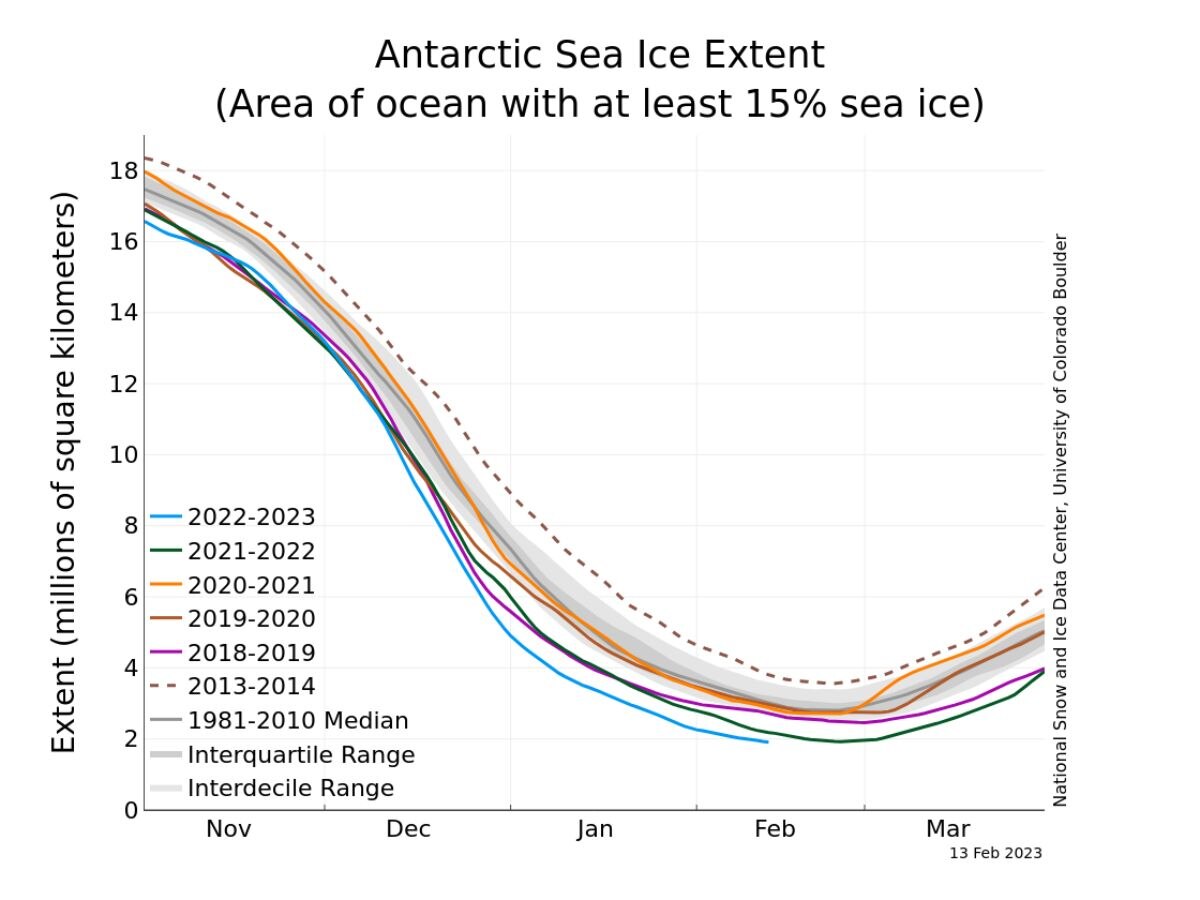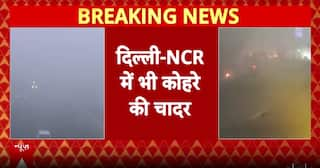Antarctic Sea Ice Falls To New Record Low Level, Expected To Drop Further. Know The Science Behind It
On February 13, 2023, the Antarctic sea ice extent dropped to 1.91 million square kilometres. This is a new record low. The ice extent is expected to decline further before reaching its annual minimum

Antarctic sea ice levels set a new record low on February 13, 2023, according to the National Snow & Ice Data Center (NSIDC), a United States information centre in support of polar and cryospheric research. The Antarctic sea ice extent is expected to decline further before reaching its annual minimum.
On February 13, the sea ice extent dropped to 1.91 million square kilometres. This is a new record low because the Antarctic sea ice extent has dropped below the previous record of 1.92 million square kilometres, which was set on February 25, 2022. The year 2023 marks the second year that Antarctic extent has fallen below two million square kilometres.
In past years, the annual minimum of the Antarctic sea ice extent occurred between February 18 and March 3. Therefore, further decline is expected, according to the NSIDC.
The annual Antarctic melt season ends in early March.
Much of the Antarctic coast is ice free, and exposes the ice shelves that border the ice sheet to warmer conditions.

The above image is a map of Antarctica that shows many low areas of sea ice concentration. These areas are depicted as darker blues, and surround the continent. The orange line shows the 1981 to 2010 median extent for February 13.

The above graph shows the Antarctic sea ice extent as of February 13, 2023, along with daily ice extent data for four previous years: 2021-2022, 2020-2021, 2019-2020, and 2018-2019. It also shows the daily ice extent data for 2013-2014, the record high year. The graph represents 2022-2023, 2021-2022, 2020-2021, 2019-2020, and 2018-2019 in blue, green, orange, brown, and magenta respectively. The 2013-2014 line is dashed down, and the 1981-2010 median is in dark grey.
The science behind the current conditions of the Antarctic sea ice
Antarctic sea ice extent has fallen well below last year's melt season levels since mid-December. Stronger-than-average westerly winds have occurred due to a positive Southern Annular Mode.
What is Southern Annular Mode?
The Southern Annular Mode, or Antarctic Oscillation, describes the north-south movement of the westerly wind belt that circles Antarctica. The westerly wind belt dominates the middle to higher latitudes of the southern hemisphere, according to the Australian Government's Bureau of Meteorology. This belt is associated with storms and cold fronts that move from west to east, and bring rainfall to southern Australia.
The Southern Annular Mode has three phases: positive, negative and neutral. Each positive or negative Southern Annular Mode event lasts about one to two weeks, though longer periods might occur. A positive Southern Annular Mode is one in which a belt of strong westerly winds contracts towards Antarctica.
The positive mode is expected to continue for a longer period of time due to increased greenhouse gas emissions. The positive phase will continue to drive changes in the westerly winds, resulting in an increased upwelling of the warm Circumpolar Deep Water, and glacier recession in western Antarctica and the Antarctic Peninsula.
What is Circumpolar Deep Water?
The Circumpolar Deep Water is derived from a mixture of all of the world's oceans.
Poleward transport of warm Circumpolar Deep Water is linked to the melting of Antarctic ice shelves, according to a 2020 study published in the journal Science Advances.
Warm Circumpolar Deep Water upwells poleward onto the continental shelf, which refers to the edge of a continent that lies under the ocean. The depth of the water is approximately between 100 and 200 metres.
Poleward upwelling of the warm Circumpolar Deep Water is the primary mechanism that transports heat towards Antarctica's marine-terminating glaciers.
According to the study, warm Circumpolar Deep Water transport onto the continental shelf in recent years has been linked to accelerated basal melting of ice shelves. The enhanced melting of ice shelves around Antarctica could lead to accelerated glacier flow toward the ocean.
What is Amundsen Sea Low? How does it affect Antarctica’s ice levels?
The stronger-than-average westerly winds, along with a strong Amundsen Sea Low, have brought warm air to the region on both sides of the Antarctic Peninsula. The Amundsen Sea Low is a permanent atmospheric low-pressure centre located offshore of western Antarctica, and affects air and ocean temperature, sea-ice and ice shelves in the West Antarctic Region. The climatological low pressure centre is located over the extreme southern Pacific Ocean.
Since warm air has been brought to the region on both sides of the Antarctic Peninsula, the ice cover in the Amundsen and Bellingshausen Seas has been largely cleared out. The conditions have also reduced sea ice extent in the northwestern Weddell Sea.
The Bellingshausen Sea is an area along the west side of the Antarctic Peninsula, while the Weddell Sea is considered to be a southern extension of the Atlantic Ocean, and marks the northernmost part of mainland Antarctica.
Over a long stretch of the Pacific-facing coastline of Antarctica, sea ice is patchy and nearly absent.
Wave-induced stresses on floating ice shelves
According to earlier studies, low sea ice cover is linked with wave-induced stresses on the floating ice shelves that hem Antarctica. These stresses lead to the break up of weaker areas.
Over the last several years, Antarctic sea ice extent has been highly variable. The years 2022 and 2023 have had record low minimum sea ice levels. Also, four out of the five highest minimums have occurred since 2008.
According to NSIDC, the current downward linear trend in the Antarctic minimum extent from 1979 to 2023 is 2,400 square kilometres per year, or 0.9 per cent per decade. Currently, this is not statistically significant.
However, the sharp decline in sea ice extent since 2016 has fuelled research on potential causes and whether sea ice loss in the Southern Hemisphere is developing a significant downward trend.







































